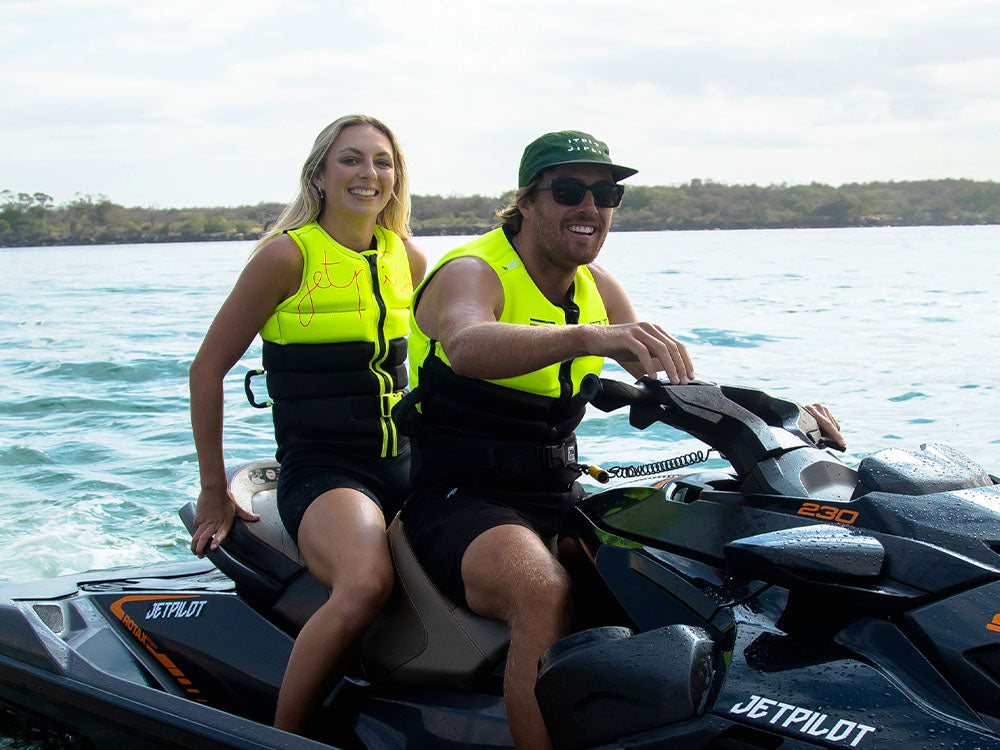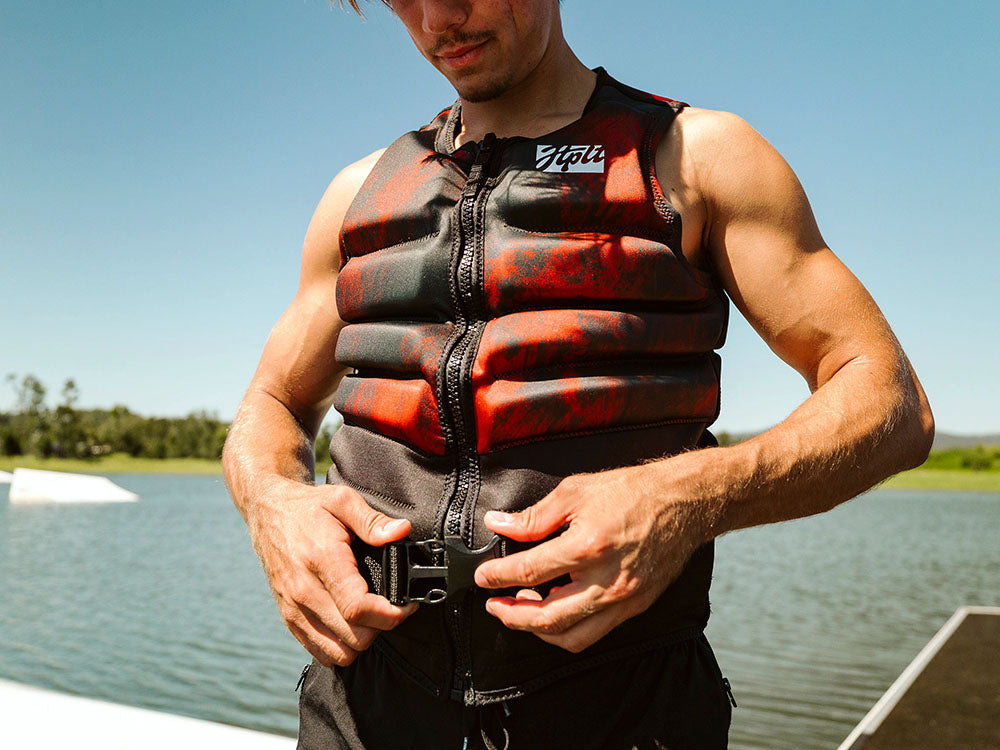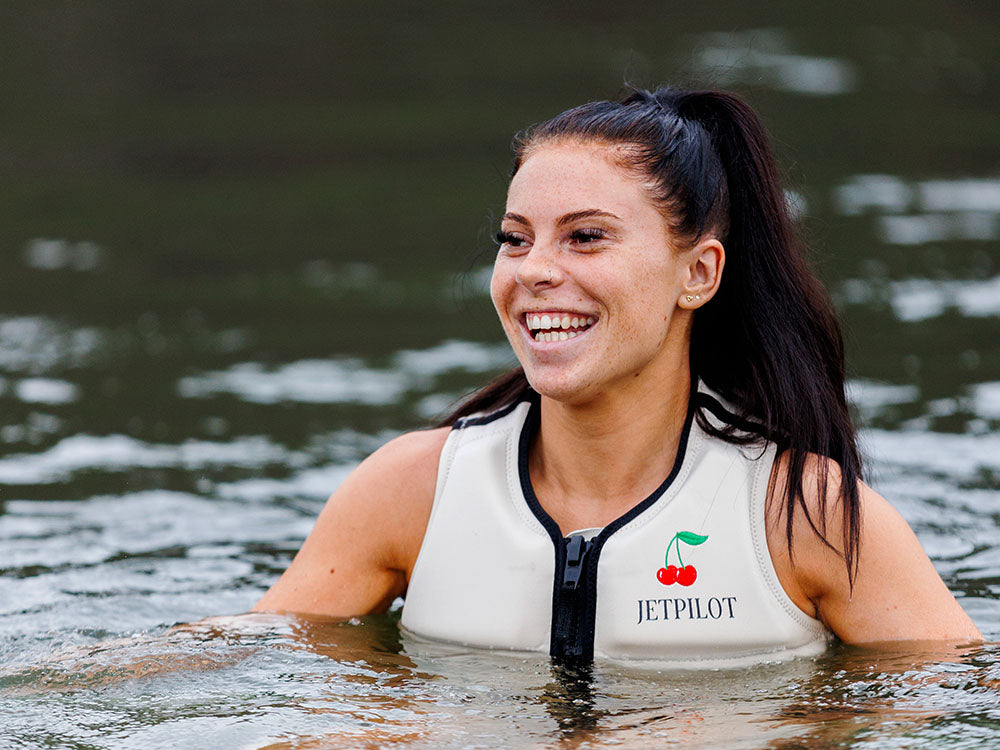A life jacket, also known as a personal flotation device (PFD), is a must-have safety flex for anyone hitting the water. They come in all sizes to keep everyone safe, from kids to adults. Whether you're out fishing, wakeboarding, jet skiing, or just vibing on a boat, a life jacket can be a total game-changer.

How Do Life Jackets Work?
Life jackets keep you afloat by providing buoyancy. They’re filled with super light materials that push water away, so you stay on top. Some are made of foam, which works instantly, while others are inflatable and use CO2 gas to get the job done when needed. Inflatable ones can be pumped up manually or automatically, making them super versatile for all kinds of water activities, including jet skiing.

How to Wear a Life Jacket
Wearing a life jacket right is key. Here’s the lowdown:
- Check the Size: Make sure the life jacket fits your weight and chest size.
- Put It On: Wear it over your clothes and fasten all buckles and zippers.
- Adjust the Fit: Tighten the straps so it’s snug but comfy. It shouldn’t be too tight or too loose.
- Test the Fit: Move around to ensure it stays in place and doesn’t ride up.
Legal Requirements for Life Jackets
In Australia, life jackets are a legal requirement, and the regulations vary depending on the state or territory you're in and the type of water you're navigating. For instance, in New South Wales and the Australian Capital Territory, every person on board a vessel must wear an approved life jacket, with specific levels required for enclosed and open waters. Similarly, in Victoria, the requirements dictate the type and level of life jacket based on whether you are in coastal or inland waters. It's important to familiarise yourself with your local regulations to ensure you are compliant and, more importantly, safe.
Types of Life Jackets
Life jackets come in various types and levels, each suited for different activities and water conditions. Understanding the differences can help you choose the right one for your needs.
Level 50 Life Jacket
A Level 50 life jacket, also known as a PFD Type 2, is mainly used in enclosed waters. It's designed for people who can swim and are close to the shore, providing support in the water without automatically turning you to a face-up position. These jackets are made in high-visibility colours to make it easier to spot you in the water.
Level 50 life jackets help keep you afloat but do not have a collar to keep your head above water. They can be worn in smooth waters as well and are suitable for skiers or people being towed in smooth or partially smooth waters. PWC riders can also use them in smooth and partially smooth waters or beyond those waters. They must comply with AS 4758 standards.
Level 50S Life Jacket
The Level 50S life jacket is similar to Level 50 but comes in a wider range of colours and styles. It's popular for activities like wakeboarding and water skiing. These jackets offer the same buoyancy and safety features as Level 50 but are designed for special purposes, hence the "S" in 50S.
Level 50S life jackets are for use in smooth water and only where the user is likely to be in the water for a short time. They may be a specified buoyancy wet suit and are suitable for skiers or people being towed in smooth waters. PWC riders can also use them in smooth waters. They must comply with AS 4758 standards.
Level 100 Life Jacket
The Level 100 life jacket, also known as a PFD Type 1, is intended for use when the shore is in sight and provides enough buoyancy to turn you face-up in the water. However, it’s not suitable for rough conditions. These jackets are designed to keep an unconscious person face-up, offering additional safety in calm waters.
Level 150 Life Jacket
For offshore and rough weather conditions, a Level 150 life jacket is ideal. It helps turn you to a face-up position when unconscious and provides a higher level of buoyancy. These jackets are suitable for more demanding conditions where rescue might take longer to arrive. They must comply with AS 4758 standards.
Level 275 Life Jacket
Level 275 life jackets provide the highest buoyancy and are intended for extreme offshore conditions. These jackets are designed for people who might be carrying heavy equipment or wearing clothing that could trap air and affect buoyancy. They ensure maximum safety by keeping the wearer face-up and their mouth and nose above water. They must comply with AS 4758 standards.

Coastal and SOLAS Life Jackets
Coastal and SOLAS life jackets have more flotation than a Level 100 life jacket. They are bulky life jackets designed to keep the body afloat for long periods. They have reflective tape and a whistle to attract attention. These life jackets are mostly carried by commercial boats and are recommended to be carried by boats operating long distances offshore.
Inflatable Life Jackets
Inflatable life jackets are a popular option, especially for boating. These jackets use CO2 for buoyancy, making them lighter and less bulky than traditional foam life jackets. They come in manual and automatic inflation types. Manual inflatable life jackets require the wearer to pull a tab to inflate, while automatic ones inflate upon contact with water. However, they’re not recommended for children under 12 years, personal watercraft operators, or anyone being towed, as they require the ability to activate them manually in an emergency.
Inflatable life jackets must comply with the same standards as foam life jackets and must be gas inflated, not relying on oral inflation only. They are also required to have markings that show the level of buoyancy provided. Inflatable life jackets used on a recreational boat must show an expiry date and be serviced before the expiry date.
What are Life Jackets Made Out Of?
Life jackets are typically made from durable materials such as nylon or neoprene. The inside is filled with foam or inflatable bladders that provide buoyancy. Neoprene life jackets, like the Jetpilot Cause Mens Neo Life Jacket L50s, are comfortable and allow for a snug fit, which is perfect for active water sports. These materials are chosen for their durability, buoyancy, and ability to withstand the harsh conditions of saltwater and sunlight exposure.

Inside a Life Jacket
The internal components of a life jacket vary depending on its type. Non-inflatable life jackets contain foam panels that provide buoyancy, while inflatable life jackets have CO2 cartridges that inflate the jacket upon activation. For example, the Jetpilot Adult Inflatable Life Jacket L150 features CO2 cartridges that inflate the jacket, providing immediate buoyancy in emergencies. This design allows for a more compact and less restrictive fit when not inflated, making it more comfortable for extended wear.
Choosing the Right Life Jacket
When selecting a life jacket, consider the type of activity and water conditions. For high-speed water sports, a Jetpilot Cause Life Jacket L50 is ideal due to its snug fit and flexibility. These jackets are designed to stay in place during rapid movements, ensuring your safety without hindering your performance. For boating in open waters, an inflatable life jacket might be more suitable due to its lightweight and compact design, which doesn’t restrict movement and is more comfortable for long periods.

Maintaining Your Life Jacket
Proper maintenance of your life jacket is essential to ensure its effectiveness. Regularly check for wear and tear, and ensure that inflatable life jackets are serviced according to the manufacturer's recommendations. This typically includes inspecting the CO2 cartridges for leaks or damage and ensuring the manual or automatic inflation mechanisms are functioning correctly. Non-inflatable jackets should be checked for any rips, tears, or other damage to the foam panels and outer fabric. This ensures that your life jacket will perform as expected when you need it the most.
Importance of Wearing a Life Jacket
Wearing a life jacket at all times when on the water is not just a legal requirement but a critical safety measure. Even strong swimmers can find themselves in dangerous situations where a life jacket can provide the necessary buoyancy to survive until help arrives. For instance, unexpected waves, strong currents, or sudden weather changes can make it difficult to stay afloat. Whether you're on a boat, jet ski, or participating in water sports, make it a habit to wear your life jacket.
Jetpilot's Range of Life Jackets
At Jetpilot, we offer a wide range of life jackets to suit all your water activities. Our products are designed with safety, comfort, and style in mind. Check out our collection of life jackets.
The Jetpilot Adult Inflatable Life Jacket L150 is ideal for offshore activities and rough waters. It provides the necessary buoyancy and safety features to ensure your security in challenging conditions. The Jetpilot Phase Hyperflex Life Jacket is perfect for wakeboarding and water skiing with a snug and comfortable fit that allows for maximum mobility. For high-speed water sports, the Jetpilot Vault Hyperflex Life Jacket - Red L50 offers flexibility and security, ensuring you can perform at your best while staying safe.

Understanding the various types of life jackets and their specific uses is key to ensuring your safety on the water. A Level 50 life jacket, for example, is mainly used in enclosed waters and is designed for people who can swim and are close to the shore. It comes in high-visibility colours to make it easier to spot you in the water. The Level 50S life jacket is similar but is available in a wider range of colours and styles, making it popular for activities like wakeboarding and water skiing.
The Level 100 life jacket, also known as a PFD Type 1, is intended for use when the shore is in sight. It provides enough buoyancy to turn you face-up in the water, but it is not suitable for rough conditions. For offshore and rough weather conditions, a Level 150 life jacket is ideal as it helps turn you to a face-up position when unconscious. Level 275 life jackets are designed for extreme conditions, offering maximum buoyancy for those carrying heavy gear. Inflatable life jackets, such as the Jetpilot Adult Inflatable Life Jacket L150, use CO2 for buoyancy, making them lighter and less bulky than traditional foam life jackets. They come in manual and automatic inflation types, although they are not recommended for children under 12 years, personal watercraft operators, or anyone being towed.
All life jackets must be marked with the appropriate label indicating the life jacket level. This label is marked by the manufacturer and should be on the life jacket at the time of purchase.

For more information on life jackets and their requirements, you can check out the relevant state governing body: Queensland Maritime Safety, New South Wales Government, Maritime Safety Victoria, Maritime & Safety Tasmania, Northern Territory Government, Government of South Australia, Government of Western Australia. Stay safe on the water, and always wear your life jacket!







